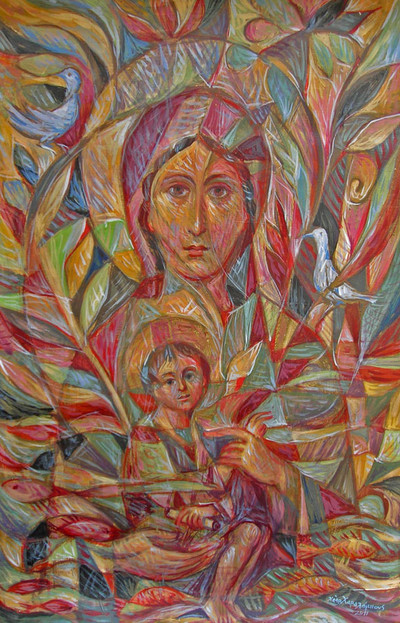
Charalambos Epaminonda
Madonna of the Woods
Acrylic on canvas
Mix art and religious dogma and the result is all too often good art with bad theology or good theology as bad art. Cypriot Icon-writer Charalambos Epaminonda achieves a masterful balance of faith and form in his painterly reflection on the doctrine of the Incarnation, Madonna of the Woods. A student of both theology and art, Charalambos presents us with a contemporary portrait of Mary and the Baby Jesus, radically different from traditional imagery of the Holy Mother and Child. Like shifting forms in a perspective picture puzzle, the central figures seem almost indistinguishable from their cubistic background of leaf and branch, fish and bird, wind-stirred forest and flowing water. The God-Become-Man and his Virgin Mother are part and parcel of the God-made universe. The Divine has come to dwell among all that has life and breath, bringing the promise of redemption and full fruition to a fallen planet. The usual iconographic colors of red and blue, representing earth and heaven, mix and mingle here with shades of gold in a scintillating palette of maroon and magenta, amber and aquamarine, lavender and lapis lazuli, cerise and cyan. Seeing this joyous image of the Madonna and Child, I think of the Apostle Paul's description in Romans 8:19-22 (NIV) of the whole creation"groaning as in the pains of childbirth," waiting "in eager anticipation for the sons of God to be revealed ...[so] that the creation itself will be liberated from its bondage of decay and brought into the freedom of the children of God." For Artist-Theologian Epaminonda, the Incarnation is not just about saving humankind but restoring all God's good creation to its intended glory. (John Kohan)
(From The Holy Bible: New International Version[NIV] (New York Bible Society International: 1973)
